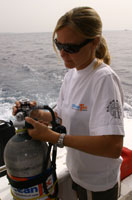The Jolanda, a 1,907 ton Cypriot cargo freighter, 74.8m long with a beam of 11.7m was laden with bathroom suites when she hit the reef in 1980, where she then lay in the shallows, (10 – 25m), for several years. Many of the containers were opened & if you have dived the area you would have seen the rows of baths together with piles of sinks & toilets and what is left of a BMW. A storm in 1986 sent the Jolanda plummeting down the slope to her final resting place after breaking into two sections; the bow sits at 150-160m & the stern at 205m.
The 160 project was the result of over 6 months preparation by Ocean Tecs’ duo, Nina & her buddy, Neil Black. Both are technical instructors based in Sharm el Sheikh, so diving regularly in good conditions was the easy part. Finding the wreck was another story, as Nina tells us:

“Jolanda had been found at depth by Leigh Cunningham & Mark Andrews in December 2005. GPS co-ordinates had been recorded but subsequently lost so we had to search again, but at least with a vague idea of the location. One might think that one could just follow the trail of toilets & debris down the reef. This is, of course, possible to an extent, but it would mean a lot of swimming (the wreck sits approx 130m out from the reef) which shouldn’t really be considered at that depth & a lot more gas than the 7 cylinders we used would be required. Also, with that many cylinders you’re obviously not dynamic in the water. To dive to 160m you want to drop straight down.
Luckily we had Leigh in our support team so he could guide us in the right direction. On one dive, Neil used a scooter to hover over the top of the wreck whilst sending up an SMB to mark the spot for the GPS. It still took us several dives to find the wreck, mostly because of the currents.
Neil & I dived over the top of Jolanda bow many times to a max depth of 130m and then obtained permission from DAN & EULF to go deeper. We did a series of dives on the wreck during the 2 weeks of the project as we only had a short bottom time, starting our ascent on minute 9.
